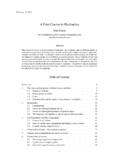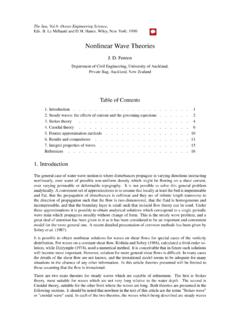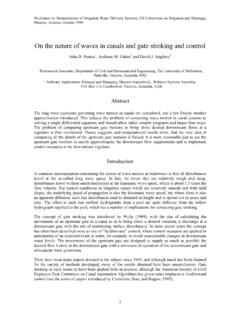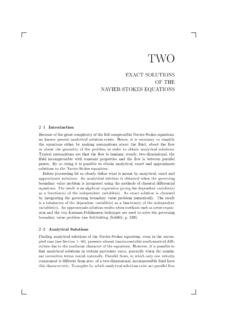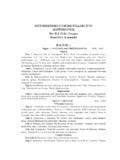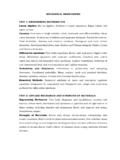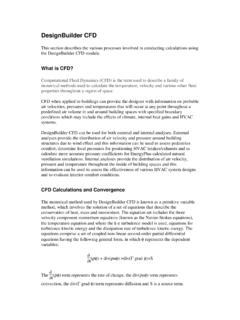Transcription of River Engineering - JohnDFenton
1 River EngineeringJohn FentonInstitute of Hydraulic and Water ResourcesEngineeringVienna University of TechnologyJune 20, 2011 Table of ContentsTable of Contents21 The nature of what we will and will not do illuminated by some aphorisms and some The problem 42 River A note on terminology in the English language: .. Structures, controls, and boundary Measurement and Computational hydraulics805 Sediment Bedforms and alluvial ..816 River .. Longitudinal profile .. Bifurcations and River .. Water quality The nature of what we will and will not do illuminated by some aphorismsand some people"There is nothing so practical as a good theory" stated in 1951 by Kurt Lewin (D-USA, 1890-1947): this isessentially the guiding principle behind these lectures. We want to solve practical problems, both in professionalpractice and research, and to do this it is a big help to have a theoretical understanding and a framework.
2 We claimto aspire to deep connected simplicity rather than shallow disparate complexity."The purpose of computing is insight, not numbers" the motto of a 1973 book on numerical methods forpractical use by the mathematician Richard Hamming (USA, 1915-1998?). That statement has excited the opinionsof many people (search any three of the words in the Internet!). However, in contradiction to Hamming s assertion,numbers are often important in Engineering , whether for design, control, or other aspects of the practical characteristic of many engineers, however, is that they are often blinded by the numbers, and do not seek thephysical understanding that can be a valuable addition to the numbers. In this course we are not going to deal withmany numbers. Instead we will deal with the methods by which numbers could be obtained in practice, and willtry to obtain insight into those methods. Hence we might paraphrase simply: "The purpose of this course is insightinto the behaviour of rivers;with that insight, numbers can be often be obtained more simply, cheaply, and reliably.
3 "It is EXACT, Jane" a story told to the lecturer by a botanist colleague. The most important River in Australia isthe Murray River ,2 375 km(Danube2 850 km), maximum recordedflow3 950 m3s 1(Danube at Iron Gate Dam:15 400 m3s 1). It has many tributaries,flow measurement in the system is approximate and intermittent, there ishuge biological andfluvial diversity and irregularity. My colleague, non-numerical by training, had just seen thedemonstration by an hydraulic engineer of a computational model of the River . She asked: "Just how accurate isyour model?". The engineer replied intensely: "It is EXACT, Jane".Nothing in these lectures will be exact. We are talking about themodellingof complex physical further example of the sort of thinking that we would like to avoid: in the area of palaeo-hydraulics, someAustralian researchers made a survey to obtain the heights offloods at individual trees. This showed that the palaeo-flood reached a maximum height on the River Murray at a certain position m(sic), Having measured thecross-section of the River , they applied the Gauckler-Manning-Strickler Equation to determine the discharge of theprehistoricflood, stated to be7 686 m3s 1(sic).
4 William of Ockham (England, c1288-c1348):"Occam" s razor is the principle that can be popularly stated as"when you have two competing theories that make similar predictions, the simpler one is the better." The term razorrefers to the act of shaving away unnecessary assumptions to get to the simplest explanation, attributed to 14th-century English logician and Franciscan friar, William of Ockham. The explanation of any phenomenon shouldmake as few assumptions as possible, eliminating those that make no difference in the observable predictionsof the explanatory hypothesis or theory. When competing hypotheses are equal in other respects, the principlerecommends selection of the hypothesis that introduces the fewest assumptions and postulates the fewest entitieswhile still sufficiently answering the question. That is, we should notover-simplify our general, model complexity involves a trade-off between simplicity and accuracy of the model.
5 Occam s Razoris particularly relevant to modelling. While added complexity usually improves thefit of a model, it can make themodel difficult to understand and work principle has inspired numerous expressions including "parsimony of postulates", the "principle of simplicity",the "KISS principle" (Keep It Simple, Stupid). Other common restatements are:Leonardo da Vinci (I, 1452 1519, world s most famous hydraulician, also an artist) his variant short-circuits theneed for sophistication by equating it to simplicity "Simplicity is the ultimate sophistication".Wolfang A. Mozart (A, 1756 1791) "Gewaltig viel Noten, lieber Mozart", soll Kaiser Joseph II. ber die erste dergro en Wiener Opern, die "Entf hrung", gesagt haben, und Mozart antwortete: "Gerade so viel, Eure Majest t,als n tig ist." (Emperor Joseph II said about thefirst of the great Vienna operas, "Die Entf hrung aus dem Serail","Far too many notes, dear Mozart", to which Mozart replied "Your Majesty, there are just as many notes as are3necessary").
6 The truthfulness of the story is questioned - Joseph was more sophisticated than that ..Albert Einstein (D-USA,1879-1955): "Make everything as simple as possible, but not simpler."Karl Popper (A-UK, 1902-1994)argued that a preference for simple theories need not appeal to practical oraesthetic considerations. Our preference for simplicity may be justified by his falsifiability criterion: We prefersimpler theories to more complex ones "because their empirical content is greater;and because they are bettertestable". In other words, a simple theory applies to more cases than a more complex one, and is thus more easilyfalsifiable. Popper coined the term critical rationalism to describe his philosophy. The term indicates his rejectionof classical empiricism, and of the classical observationalist-inductivist account of science that had grown out ofit. Logically, no number of positive outcomes at the level of experimental testing can confirm a scientific theory(Hume s "Problem of Induction"), but a single counterexample is logically decisive: it shows the theory, fromwhich the implication is derived, to be false.
7 For example, consider the inference that "all swans we have seen arewhite, and therefore all swans are white," before the discovery of black swans in Australia. Popper s account ofthe logical asymmetry between verification and falsifiability lies at the heart of his philosophy of science. It alsoinspired him to take falsifiability as his criterion of demarcation between what is and is not genuinely scientific:a theory should be considered scientific if and only if it is falsifiable. This led him to attack the claims of bothpsychoanalysis and contemporary Marxism to scientific status, on the basis that the theories enshrined by them arenot , however, seems not so important a principle when it comes to Engineering . Another objection isthat it is not always possible to demonstrate falsehood definitively, especially if one is using statistical criteria toevaluate a null hypothesis. More generally it is not always clear, if evidence contradicts a hypothesis, that thisis a sign offlaws in the hypothesis rather than offlaws in the evidence.
8 However, this is a misunderstanding ofwhat Popper s philosophy of science sets out to do. Rather than offering a set of instructions that merely needto be followed diligently to achieve science, Popper makes it clear inThe Logic of ScientificDiscoverythat hisbelief is that the resolution of conflicts between hypotheses and observations can only be a matter of the collectivejudgment of scientists, in each individual Kuhn (USA, 1922-1996):InThe Structure of Scientific Revolutionsargued that scientists work in a seriesof paradigms, and found little evidence of scientists actually following a falsificationist methodology. Popper sstudent Imre Lakatos (H-UK, 1922-1974) attempted to reconcile Kuhn s work with falsificationism by arguingthat science progresses by the falsification of research programs rather than the more specific universal statementsof naive argued that as science progresses, explanations tend to become more complex before aparadigm shiftoffersradical simplification.
9 For example Newton s classical mechanics is an approximated model of the real , it is quite sufficient for most ordinary-life seems to have anticipated Kuhn s observations. In his collectionConjectures and Refutations: The Growthof Scientific Knowledge(Harper & Row, 1963), Popper writes, "Science must begin with myths, and with thecriticism of myths;neither with the collection of observations, nor with the invention of experiments, but with thecritical discussion of myths, and of magical techniques and practices. The scientific tradition is distinguished fromthe pre-scientific tradition in having two layers. Like the latter, it passes on its theories;butitalsopassesonacritical attitude towards them. The theories are passedon, not as dogmas, but rather with the challenge to discussthem and improve upon them."Another of Popper s students Paul Feyerabend (A-USA, 1924-1994) ultimately rejected any prescriptive method-ology, and argued that the only universal method characterizing scientific progress was "anything goes!
10 "The utility of deep simplicity compared with shallow complexityIn view of the above, the lecturer prefers to approach problems with the former, deep simplicity, rather than thelatter, shallow complexity. The following lecture notes will be a reflection of that. Unfortunately "deep" sometimeslooks complicated atfirst, which can be off-putting. However, once a principle or a practice is established orunderstood, it seems simple in The problem offlow in a riverThe governing equations are the three-dimensional equations of mass and momentum conservation, the latter calledthe Navier-Stokes equations, which are partial differential equations that describe the distribution of velocity andpressure throughout afield offlow. They are valid at small (microscopic) scales and large (atmospheric andoceanic) scales. For most practical problems in waterflow, theflow becomes unstable: paradoxically, the viscosity4whose primary role is as a momentum diffusionor smoothing phenomenon, actually causes theflows to be unstableand to become turbulent.


